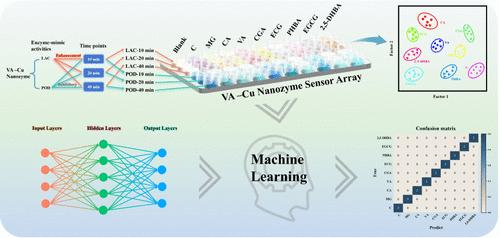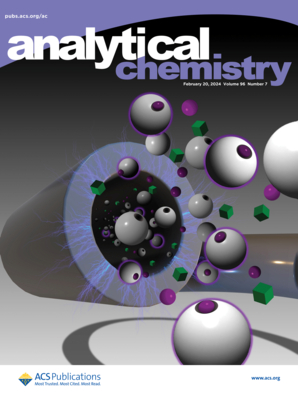Machine Learning-Based Nanozyme Sensor Array as an Electronic Tongue for the Discrimination of Endogenous Phenolic Compounds in Food
IF 6.7
1区 化学
Q1 CHEMISTRY, ANALYTICAL
引用次数: 0
Abstract
The detection of endogenous phenolic compounds (EPs) in food is of great significance in elucidating their bioactivity and health effects. Here, a novel bifunctional vanillic acid-Cu (VA-Cu) nanozyme with peroxidase-like and laccase-like activities was successfully prepared. The peroxidase mimic behavior of VA-Cu nanozyme can catalyze 3,3′,5,5′-tetramethylbenzidine (TMB) to generate oxidized TMB (oxTMB). Owing to the high reducing power of EPs, this process can be inhibited, and the degree of inhibition increases with the increase of reaction time. Additionally, owing to the outstanding laccase mimic behavior of the VA-Cu, it can facilitate the oxidation of various EPs, resulting in the formation of colored quinone imines, and the degree of catalysis increases with the increase of reaction time. Based on the interesting experimental phenomena mentioned above, a six-channel nanozyme sensor array (2 enzyme-mimic activities × 3 time points = 6 sensing channels) was constructed, successfully achieving discriminant analysis of nine EPs. In addition, the combination of artificial neural network (ANN) algorithms and sensor arrays has successfully achieved accurate identification and prediction of nine EPs in black tea, honey, and grape juice. Finally, a portable method for identifying EPs in food has been proposed by combining it with a smartphone.

基于机器学习的纳米酶传感器阵列作为电子舌辨别食品中的内源性酚类化合物
检测食品中的内源性酚类化合物(EPs)对阐明其生物活性和健康影响具有重要意义。本文成功制备了一种新型双功能香草酸-铜(VA-Cu)纳米酶,它具有类似过氧化物酶和类似裂解酶的活性。VA-Cu 纳米酶的过氧化物酶模拟行为可催化 3,3′,5,5′-四甲基联苯胺(TMB)生成氧化 TMB(oxTMB)。由于 EPs 具有很强的还原能力,因此可以抑制这一过程,而且抑制程度会随着反应时间的延长而增加。此外,由于 VA-Cu 具有出色的漆酶模拟行为,它可以促进各种 EPs 的氧化,从而形成有色的醌亚胺,并且催化程度随着反应时间的延长而增加。根据上述有趣的实验现象,构建了六通道纳米酶传感器阵列(2 个酶模拟活性 × 3 个时间点 = 6 个传感通道),成功实现了对 9 种 EP 的判别分析。此外,将人工神经网络(ANN)算法与传感器阵列相结合,成功实现了对红茶、蜂蜜和葡萄汁中九种 EPs 的准确识别和预测。最后,通过与智能手机的结合,提出了一种用于识别食品中 EPs 的便携式方法。
本文章由计算机程序翻译,如有差异,请以英文原文为准。
求助全文
约1分钟内获得全文
求助全文
来源期刊

Analytical Chemistry
化学-分析化学
CiteScore
12.10
自引率
12.20%
发文量
1949
审稿时长
1.4 months
期刊介绍:
Analytical Chemistry, a peer-reviewed research journal, focuses on disseminating new and original knowledge across all branches of analytical chemistry. Fundamental articles may explore general principles of chemical measurement science and need not directly address existing or potential analytical methodology. They can be entirely theoretical or report experimental results. Contributions may cover various phases of analytical operations, including sampling, bioanalysis, electrochemistry, mass spectrometry, microscale and nanoscale systems, environmental analysis, separations, spectroscopy, chemical reactions and selectivity, instrumentation, imaging, surface analysis, and data processing. Papers discussing known analytical methods should present a significant, original application of the method, a notable improvement, or results on an important analyte.
 求助内容:
求助内容: 应助结果提醒方式:
应助结果提醒方式:


